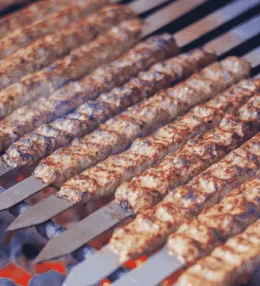
- View
Table of Contents
ToggleChess pie is one of those traditional Southern desserts that manages to feel both rustic and indulgent. It is the kind of pie you might find cooling on a windowsill in a small town bakery, its golden top just slightly cracked from the heat of the oven. Made from everyday pantry staples, it transforms simple ingredients into something undeniably rich and satisfying.
This custard style pie has earned a quiet reverence across the American South, often appearing at holiday tables, church socials and Sunday dinners. Its appeal lies in its balance of buttery sweetness and creamy texture, wrapped in a flaky crust that keeps each slice neat but never boring. There is comfort in its familiarity, but also a bit of mystery in its curious name.
Want to dive deeper into American Cuisine? Don’t miss our post on 65 Traditional American Foods to Try
What Is Chess Pie?
Chess pie is a baked custard pie, typically made with a filling of eggs, sugar, butter and cornmeal. It is poured into an unbaked pastry crust and baked until the top sets and takes on a delicate crackle. Some versions include a splash of vinegar or lemon juice, which adds a hint of tang to balance the sweetness.
This pie is served at room temperature, often with nothing more than a dusting of powdered sugar. It is dense, not airy like some custards, and its texture sits somewhere between a gooey brownie centre and a buttery curd. You do not need toppings to enjoy it. It holds its own with every forkful.
Ingredients and Taste
The base ingredients are modest: eggs for structure, sugar for sweetness, butter for richness and a spoonful of cornmeal which gives the filling its subtle grit and signature texture. Some recipes call for milk or cream, while others stay true to their more frugal roots and leave it out.
The pie is sweet, make no mistake, but not cloying. The cornmeal provides a slight crunch, while the buttery custard melts slowly on the tongue. If vinegar or citrus is used, it cuts through the sugar just enough to keep each bite from becoming too heavy. The crust adds a crisp contrast that completes the experience.
A Taste of History
The exact origin of the name chess pie is a bit of a puzzle. Some say it comes from the phrase just pie, spoken in a Southern drawl. Others believe it may relate to the old term pie chest, a piece of furniture used to store baked goods before refrigeration. Neither theory is definitive, but both reflect the pie’s humble beginnings.
What is certain is that chess pie emerged from a place of practicality. It was born from the need to make dessert with what was already in the kitchen. No fruit, no chocolate, just sugar, eggs and staples. It became a standard in Southern homes, a dessert that could always be relied upon.
Today, chess pie continues to hold its place on American tables not because it is fancy, but because it is dependable. It is sweet without pretence, rich without extravagance and simple in the best possible way. Whether baked for a celebration or made on a whim, it tells a story of Southern resilience and everyday joy.
How to make Traditional Chess Pie
A Southern classic through and through, Chess Pie is rich, sweet, and silky with a delicate crunch from cornmeal. The custard filling sets up into a beautifully golden top, and it’s surprisingly simple to make. Expect buttery richness, a whisper of tang from vinegar, and a crackly top that gives way to smooth filling. See the recipe card at the bottom for printable directions
Ingredients
For the filling:
- 150 grams granulated sugar
- 1 tablespoon fine yellow cornmeal
- 1 tablespoon all-purpose flour
- 60 grams unsalted butter, melted and slightly cooled
- 2 medium eggs
- 120 millilitres whole milk
- 1 tablespoon white vinegar
- 1 teaspoon pure vanilla extract
- A pinch of salt
For the crust:
- 1 half of a 23 cm prepared shortcrust pastry, fitted into a 12–15 cm pie dish
Cooking Instructions
Step 1: Prepare the oven and crust
To begin, preheat your oven to 180°C (350°F). Fit the shortcrust pastry into a small pie dish and crimp the edges neatly. Chill the crust in the fridge while preparing the filling to help prevent shrinkage during baking.
Step 2: Mix the dry ingredients
In a large bowl, whisk together the sugar, cornmeal, flour, and salt. Stir until the mixture is evenly combined and free of any lumps. This base gives the filling its signature texture.
Step 3: Add the wet ingredients
Pour in the melted butter, then add the eggs one at a time, whisking gently to blend. Avoid vigorous mixing to prevent too much air from being incorporated into the custard.
Step 4: Finish the custard mixture
Add the milk, vinegar, and vanilla extract to the bowl. Stir gently until the mixture is smooth and creamy. The vinegar adds a subtle brightness that balances the sweetness.
Step 5: Fill the pie shell
Remove the chilled pie crust from the fridge. Carefully pour the custard filling into the prepared crust. Tap the pie dish lightly on the counter to release any trapped air bubbles.
Step 6: Bake the pie
Place the pie on the middle oven rack and bake for 40 to 45 minutes. The filling should be mostly set with a slight wobble in the centre, and the top should form a golden, lightly crisped surface.
Step 7: Cool the pie
Once baked, transfer the pie to a wire rack and let it cool completely at room temperature. The filling will firm up as it cools, making it easier to slice cleanly.
Step 8: Chill before serving
For the best texture, chill the pie for at least 1 hour after cooling. This helps the custard set to a sliceable firmness and enhances its flavour.
Step 9: Slice and garnish
Slice the pie into four even portions. Serve plain or with a dollop of freshly whipped cream. A dusting of icing sugar can add a touch of elegance if desired.
Final step: Serve and enjoy
Enjoy Chess Pie slightly chilled or at room temperature. It pairs beautifully with hot tea or black coffee. Store leftovers covered in the fridge for up to three days.
Cooking Tips for Perfect Chess Pie
- Use room temperature eggs for a smoother custard consistency.
- Do not skip the vinegar as it balances the sweetness and adds the traditional flavour profile.
- Avoid overbaking or the custard may crack. It should jiggle slightly when done.
- Use fine cornmeal for a more delicate texture. Coarse cornmeal will give the filling a grainy mouthfeel.
- Shield crust edges with foil if they begin browning too quickly during baking.

Chess Pie (Custard Pie with Cornmeal)
Ingredients
For the filling:
- 150 grams granulated sugar
- 1 tablespoon fine yellow cornmeal
- 1 tablespoon all-purpose flour
- 60 grams unsalted butter melted and slightly cooled
- 2 medium eggs
- 120 millilitres whole milk
- 1 tablespoon white vinegar
- 1 teaspoon pure vanilla extract
- A pinch of salt
For the crust:
- 1 half of a 23 cm prepared shortcrust pastry fitted into a 12–15 cm pie dish
Instructions
- To begin, preheat your oven to 180°C (350°F). Fit the shortcrust pastry into a small pie dish and crimp the edges neatly. Chill the crust in the fridge while preparing the filling to help prevent shrinkage during baking.
- In a large bowl, whisk together the sugar, cornmeal, flour, and salt. Stir until the mixture is evenly combined and free of any lumps. This base gives the filling its signature texture.
- Pour in the melted butter, then add the eggs one at a time, whisking gently to blend. Avoid vigorous mixing to prevent too much air from being incorporated into the custard.
- Add the milk, vinegar, and vanilla extract to the bowl. Stir gently until the mixture is smooth and creamy. The vinegar adds a subtle brightness that balances the sweetness.
- Remove the chilled pie crust from the fridge. Carefully pour the custard filling into the prepared crust. Tap the pie dish lightly on the counter to release any trapped air bubbles.
- Place the pie on the middle oven rack and bake for 40 to 45 minutes. The filling should be mostly set with a slight wobble in the centre, and the top should form a golden, lightly crisped surface.
- Once baked, transfer the pie to a wire rack and let it cool completely at room temperature. The filling will firm up as it cools, making it easier to slice cleanly.
- For the best texture, chill the pie for at least 1 hour after cooling. This helps the custard set to a sliceable firmness and enhances its flavour.
- Slice the pie into four even portions. Serve plain or with a dollop of freshly whipped cream. A dusting of icing sugar can add a touch of elegance if desired.
- Enjoy Chess Pie slightly chilled or at room temperature. It pairs beautifully with hot tea or black coffee. Store leftovers covered in the fridge for up to three days.
Nutrition
You May Also Like







Leave a Review